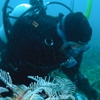General Description
Colony of individual polyps (hydranths) joined by root-like network of tubular stolons at the base. Colony shape is tree-like or bushy (arborescent). Colour: colony and corbulae pale grey, gonophores white to cream. Up to 5 cm high.
Biology
This is one of the most spectacular and graceful hydroids in southern Australia. The often form dense colonies on sponges and ascidians. Their colonies grow and become fertile in autumn to winter.
Habitat
On sponges and compound ascidians, in sheltered waters.
Reefs
Distribution guide
New Zealand and southern Australia.
Species Group
Depth
Water Column
Max Size
5 cm
Diet
Plankton or Particles
Harmful
Generally not harmful but still able to sting bare skin.
Commercial Species
No
Global Dispersal
Recorded in Australia
Species Code
MoV 3465
Identify
Conservation Status
- DSE Advisory List : Not listed
- EPBC Act 1999 : Not listed
- IUCN Red List : Not listed






